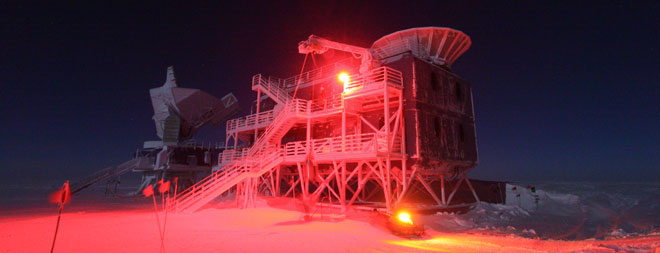Scientists Report Evidence for Gravitational Waves in Early Universe

Liquid Helium is being delivered by snowmobile to BICEP2.
Robert Schwarz, University of Minnesota
(Inside Science) -- In what would represent the most direct evidence of Albert Einstein’s last major unconfirmed prediction, as well as a powerful confirmation of a violently fast expansion of the early cosmos, scientists using a cutting-edge South Pole telescope announced evidence for the first detection of gravitational waves in the initial moments of the universe.
Outside experts reacted enthusiastically to the results, but cautioned that the data has unusual characteristics that may ultimately conflict with earlier observations and could require more complicated models for the universe’s early expansion than previously expected.
The announcement was made by the brawny-sounding BICEP2 collaboration, which actually translates into the brainier name of "Background Imaging of Cosmic Extragalactic Polarization." The BICEP2 team announced their results today in a series of scientific presentations and a news conference at the Harvard-Smithsonian Center for Astrophysics in Cambridge, Mass. The collaboration posted a preprint of their paper which has been submitted for publication and will undergo scientific peer review.
"Detecting this signal is one of the most important goals in cosmology today," said Harvard-Smithsonian’s John Kovac, BICEP2’s principal investigator, in a statement.
Through decades of observations, scientists have been able to estimate that the universe began 13.8 billion years ago, but how the primordial universe developed into today’s universe remains mysterious. In January 1980, MIT theorist Alan Guth proposed an idea, highly controversial at the time, that the early universe underwent an amazing growth spurt, known as cosmic inflation, multiplying its size by as much as 10 trillion trillion trillion times in the first fractions of a second, before expanding at a more normal rate.
Evidence for inflation began to accumulate in the early 1990s, when scientists began to make detailed measurements of the very first light released after the Big Bang. This light continues to pour in from the edge of the observable universe and is stretched out to microwave radiation by the time it reaches the Earth.
Starting in the 1990s, researchers found that this cosmic microwave radiation contains tiny variations in temperature across the sky. These tiny variations, caused by energy fluctuations explained by the theory of quantum mechanics, revealed regions of high and low density of matter. These regions would evolve into large clusters of galaxies and voids between galaxy clusters in the later universe. Inflation helped these tiny density variations to translate quickly into either large galaxy-scale structures or huge voids in space. The first measurements of the cosmic microwave background provided evidence of "density waves" and helped to build support for the idea of cosmic inflation.
Gravity was also present in the early universe. When an object with mass accelerates, Einstein's theory of General Relativity predicted that it will create gravitational waves, which are ripples in spacetime. Passing through the Earth, gravitational waves would actually cause our planet to expand and contract very slightly. These ripples are so small that they have not been directly detected to this point. But inflation of the early universe would have amplified these gravitational waves to the point that they would make a noticeable imprint in the cosmic microwave radiation.
By finding evidence of these gravitational imprints, "today we detected the other half of inflation," said collaboration co-leader Chao-Lin Kuo, a professor at Stanford University and the SLAC National Accelerator Laboratory, at the news conference.
Like many other instruments of its type, the BICEP2 telescope is deployed in the South Pole, where the cold, dry and clear conditions enable clear observations of the sky with very few distortions from the atmosphere. The BICEP2 telescope trained its sights on chunks of the sky measuring from one to five degrees, about two to ten times the Moon’s width.
It measured a property in the cosmic microwave background known as polarization. Polarization is a property that can be experienced when wearing sunglasses or 3D glasses for movies. Sunlight gets reflected from the ground, and the reflected light is polarized—the electric field of the reflected light is vibrating along a particular direction. Polarized sunglasses block this glare so we can see more clearly.
Similarly, gravitational waves passing through space would tend to create a polarization in the light it passes through. The researchers detected high levels of this "B-mode" polarization that are believed to be a signature for passing gravitational waves.
"This has been like looking for a needle in a haystack, but instead we found a crowbar," BICEP2 co-leader Clem Pryke of the University of Minnesota stated colorfully in the news release for the announcement.
Others responded with cautious excitement about the result.
"If the data is correct, it provides our strongest evidence for inflation," Princeton physicist David Spergel, who was not part of the team, wrote to Inside Science. "The BICEP result appears to show evidence for gravitational waves, which are [an] inflationary prediction and one of its most distinctive."
"Given the importance of this result, my starting point is to be skeptical," Spergel added. "Most importantly, there are several independent experimental groups that will test this result in the next year."
"The results reported by the BICEP collaboration required a very difficult and precise set of measurements," wrote Nicolas Yunes, a physicist at Montana State University, in Bozeman, in an email to Inside Science. "The collaboration has announced a strong signal and they have done a careful analysis of their systematic errors."
"If their interpretation is correct," Yunes added, "one can think of the BICEP results as the first direct detection of gravitational waves, produced at the earliest times we can observe."
"This gravitational wave fossil record is like finding the first dinosaur bones, which proved the existence of these prehistoric beasts," Yunes wrote. "To watch a movie of these 'dinosaurs' in motion -- to observe how gravitational waves evolve in time—however, we will have to wait for observations with ground-based interferometers, such as advanced LIGO and Virgo, that will see gravitational waves produced much closer to the Milky Way, during the slow 'inspiral' and merger of binary black holes and neutron stars in our and nearby galaxies."
Spergel and Yunes both indicated that some features of the data, such as the very large gravitational wave signatures that were detected relative to the density-wave signals, may not agree with previous measurements, in other physics experiments such as WMAP and Planck, unless, for example, the standard model of inflation is replaced by a more complicated one.
Gravitational wave signals can rule out a number of major models of the early universe and may provide insights into the very nature of gravity, helping physicists on their quest to reconcile general relativity, which describes the universe at large scales, and quantum mechanics, which describes the universe at the smallest scales.
If inflation is ultimately confirmed, it may support the idea of a "multiverse"—the idea that our universe is one of many in the cosmos. Gravity in different universes might have wildly different strengths than in our own. But drawing conclusions about the possibility of a multiverse seems too speculative at this point, the researchers indicated.
No matter how these results turn out, cosmology seems to have started a new chapter today.
“A new era of B-mode cosmology has begun,” reads the end of the BICEP2 paper that was submitted today.

